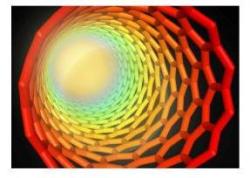May 4 2010
MIT researchers are exploring a new technology funded by the Air Force Office of Scientific Research, and the National Science Foundation, which they call a thermopower wave, that may convert chemical energy to fuel cells for micro-machines, sensors and emergency communication beacons.
 The key components of these devices are tiny, molecular wires called carbon nanotubes, or CNTs, which when coated with fuel can conduct heat and create an energy wave in the process.
The key components of these devices are tiny, molecular wires called carbon nanotubes, or CNTs, which when coated with fuel can conduct heat and create an energy wave in the process.
The technology is already generating attention because it is 100% non-toxic, saves energy and can also create a significant amount of power in tiny batteries.
"We envision these thermopower wave devices enabling a new generation of energy sources by providing more power -- as much as ten times -- than smaller commercial batteries," said Dr. Michael Strano, MIT associate professor of chemical engineering.
The key components of these devices are tiny, molecular wires called carbon nanotubes, or CNTs, which when coated with fuel can conduct heat and create an energy wave in the process.
Researchers Wonjoon Choi, Joel T. Abrahamson, Drs. Strano, Nitish Nair, Jae-Hee Han, Changsik Song and Seunghyun Hong, Prof. Seunghyun Baik believe the waves may form the basis of new types of fuel cells that convert condensed liquid fuel into electrical energy in a continuous manner.
A major challenge that the researchers faced was activating the devices without using too much energy. As a result, they explored different methods, including lasers, electrical sparks and direct heating from a resistor before they discovered the thermopower wave.
As they refine their mathematical decription of the waves, the scientists are looking forward to exploring ways to develop thermopower wave devices that can use transportation fuels such as ethanol or formic acid.
"Another important step for the researchers is to develop refueling systems that can cover the CNTs with more fuel so that the devices can be used more than once," Strano said. "This will greatly expand their potential applications."
Source: http://www.wpafb.af.mil/